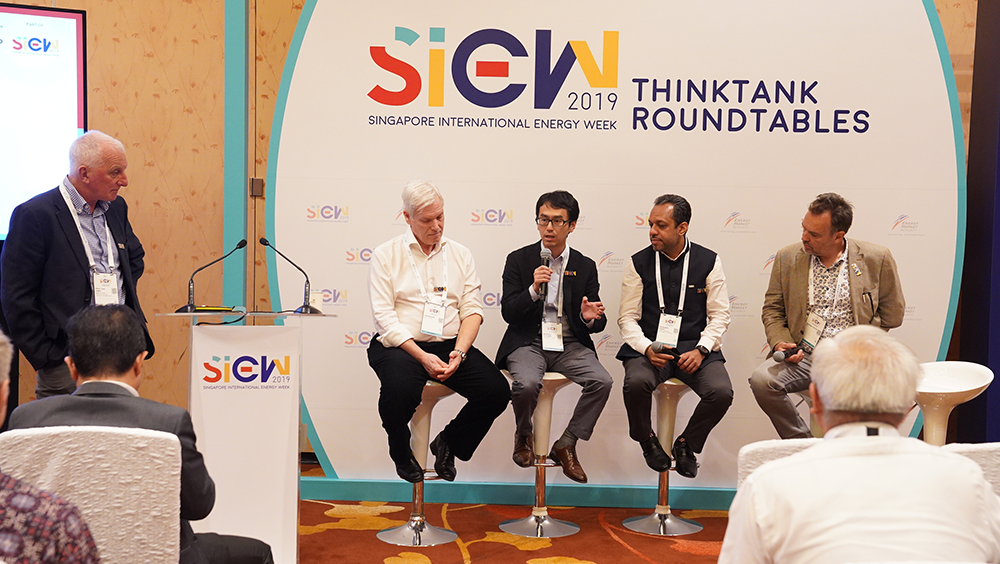
Benefits and Risks of Using Geoengineering to Combat Climate Change
By Kheng Hiang
Professor Anthony Owen, Energy Studies Institute, National University of Singapore opened Roundtable H, sharing how geoengineering can be used as a strategy for countering rising temperature caused by greenhouse gas emissions.
However, several geoengineering techniques such as aerosol injection, marine cloud brightening, high-albedo crops and buildings, cloud thinning and space sunshades, carry risks due to the scale of work required and uncertainties concerning unintended consequences. As such, there is a need to address the technical and political viability of geoengineering as a global strategy to combat climate change.
Dr. Andrew Lenton, Senior Research Scientist, Climate Science Centre Commonwealth Scientific and Industrial Research Organisation Hobart Australia, shared more on CO2 removal techniques. The scenario in the Paris agreement, of less than 2 degrees Celsius increase in global temperature, can be achieved using CO2 removal technologies. These technologies can help reduce global warming and the concentration of atmospheric greenhouse gases.
He shared that while some sectors are not easily decarbonised, such as air travel, agriculture and shipping, the emissions from these sectors can be offset by accelerating the deployment of decarbonising technologies for other sectors. Challenges in the adoption of these technologies include earth system challenges, technological challenges, social challenges and economic regulatory challenges. He further explained that removing emissions released is not the same as decreasing the atmospheric CO2 concentration, emphasizing the urgency in decarbonising the global economy.
Professor John C. Moore, Chief Scientist, Global Change and Earth System Science, Beijing Normal University, China, shared that solar radiation management is one way to reverse the changes caused by rising CO2 emissions. Climate change is felt differently in the developing world – in some countries the impact of this phenomenon is already happening, and for some it is already an existential threat. A rise in sea level will cost tens of trillions of dollars per year to the global economy in the years ahead.
Further, Dr. Arunabha Ghosh, Founder CEO Council on Energy, Environment and Water, New Delhi, India, shared that environmental uncertainties are affecting technological research, political intentions, legitimacy of forums and public trust. There is a need for more explicit links to the Paris Agreement and sustainable development goals. Dr. Arunabha shared that there is willingness to contemplate technology interventions on a planetary scale; however there is a need to establish the thresholds for research and deployment and establish precautionary principle at each stage. He cited examples of a study done by a small team across a few countries that injected particles in the atmosphere to see the dispersion, stressing the need for a more collaborative front to implement planetary-scale geoengineering projects. Organisations need to decide on the governance routes and utilise existing treaties to foster international governance, which will potentially be applicable to all geoengineering methods. The need for transparency to reduce public risk and build public trust is paramount.
The panellists agreed that ocean fertilising experiments in the Southern Ocean have increased the overall productivity of the ocean and are aiding in the sequestration of carbon dioxide within the atmosphere. The additional nutrients to the upper layers of the ocean stimulates phytoplankton activity, which could help remove carbon dioxide. However, they cautioned that there are controversial effects, and research groups must continue to study the effects of ocean fertilisation to be a viable geoengineering technology for large-scale adoption. Panellists also agreed that magnetic pole shifts have no impact on climate change.
Lastly, the panel acknowledged that there will certainly be an attempt to implement geoengineering technologies to combat climate change. It would take at least 10 years to see geoengineering technologies scale up involving international governance to execute on a planetary level. Dr. Arunabha Ghosh concluded with a promising statement, “I would say rather than who is funding, it should be a multi-country funded network.” There is past precedent, such as CERN, the large Hadron Collider, for collaboration on international programme. Dr. Ghosh adds, “The more work we do to harness geoengineering technologies, the faster we can combat climate change.”